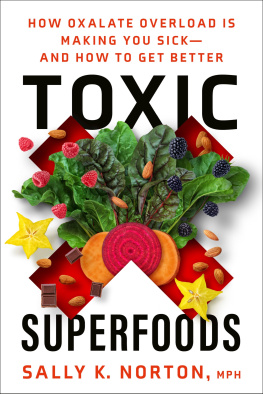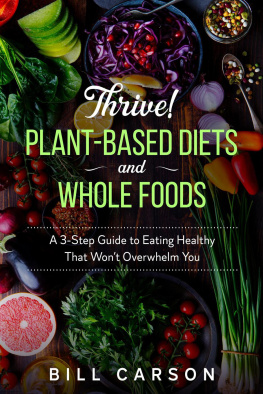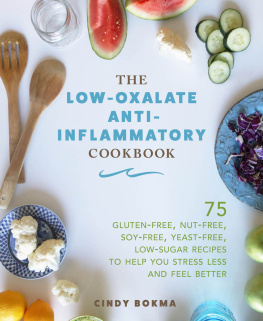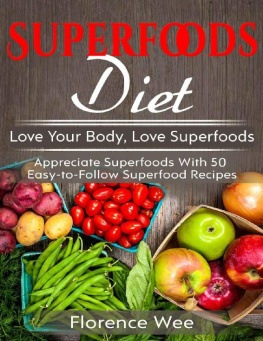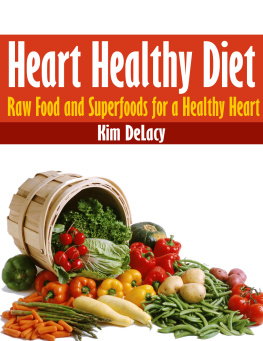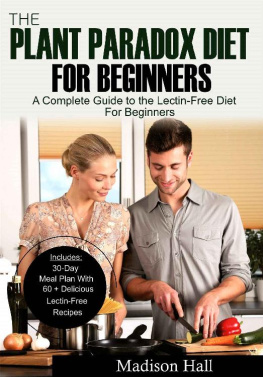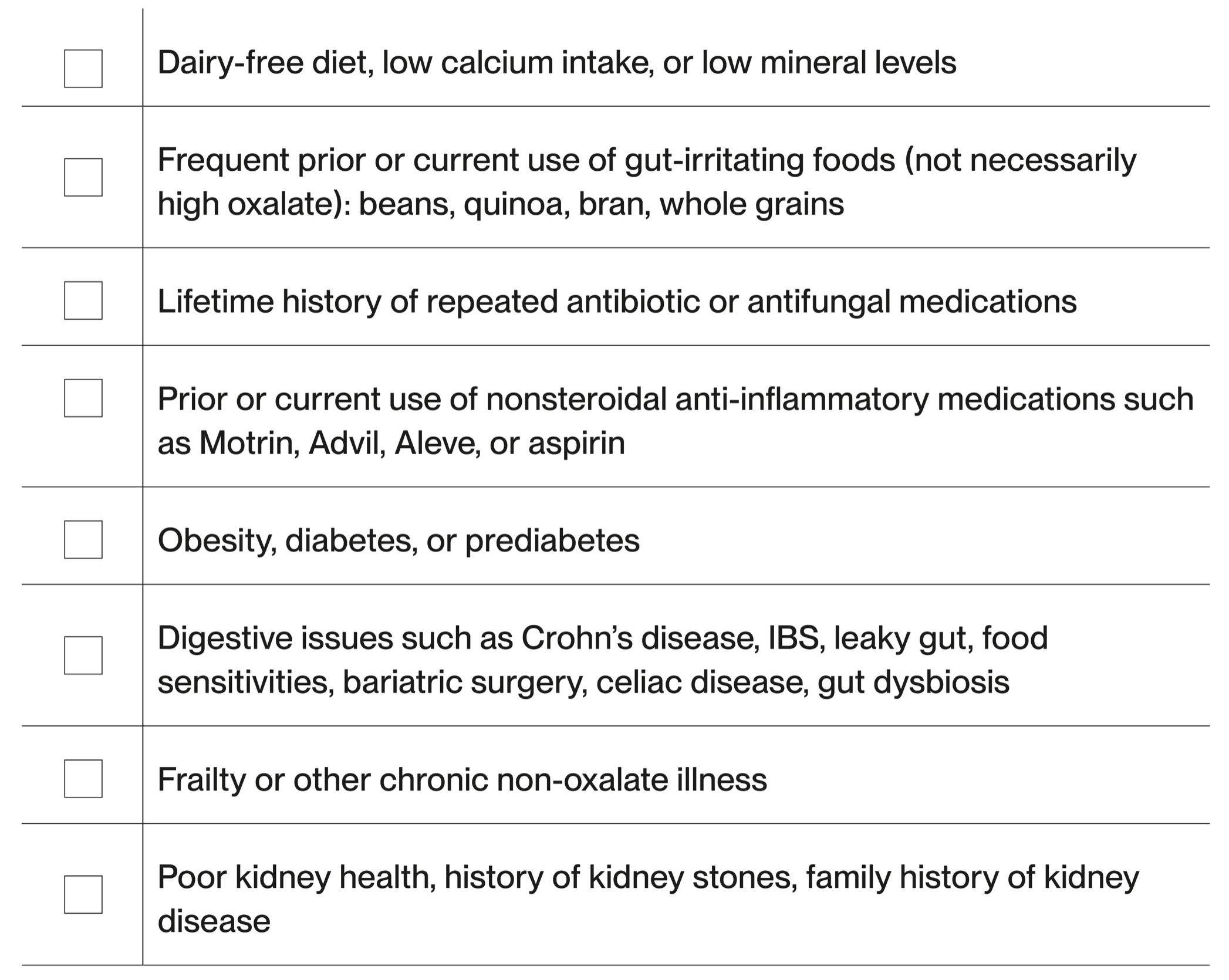Contents
Landmarks
Print Page List
Acknowledgments
First and foremost, my deepest gratitude to the founder and executive director of The Vulvar Pain Foundation, Joanne Yount; researcher and advocate Susan Costen Owens; and her champion and cheerleader, Edythe Pumfey Steffens. These pioneers clued me in to a solution to my pain when no one else could. Their work essentially saved my productive life.
Joanne Yount and Susan Owens not only rediscovered the healing power of low-oxalate eating, but their fresh insights and the resources they created made it possible for me and many others to find our way back to health. Joanne Younts foundation (VPF) has pioneered systematic and extensive food oxalate content testing, and since 1993, VPFs newsletters provided a treasure trove of information on oxalate illness and the use of low-oxalate eating to reclaim health.
Thanks to crucial support from Pumfey Steffens, Susan Owenss Autism Oxalate Project (AOP), and the Trying Low Oxalates (TLO) community that formed around it, which have created a worldwide opportunity for sharing knowledge, experience, and practical wisdom about oxalates.
This book is my contribution back to both those communities: I hope it helps many more people see the value of oxalate awareness. If readers find value in this book, I encourage them to support those organizations.
In practice, low-oxalate eating would be nowhere without the hundreds of food oxalate content tests performed and reported by Dr. Michael Liebman and his colleagues on behalf of VPF and AOP. Joanne Younts and Susan Owenss work was launched with the research and educational support of the late Clive Solomons, Ph.D., who recognized that oxalate was a concern after helping one woman. He went on to conduct thousands of urine tests, which provided the initial evidentiary basis for the emerging modern understanding of oxalates and health, and developed support therapies such as the use of calcium citrate in an effort he called the Pain Project.
Thanks also to Dr. Susan Marengo and Dr. Tanecia Mitchell for talking with me about their research on oxalates. Their work helps to explain the mechanisms of acute and chronic oxalate toxicity.
Hundreds of people have shared their stories of suffering and healing with me over the past nine years, propelling me to understand the nature of this disease by relating their experiences of oxalate overload and recovery. They have taught me just how widespread oxalate overload is and how much it can mean to find a path to recovery. I love you all. You too helped make this book possible. I hope our collective years of suffering and healing can also help others avoid needless pain.
Many special folks quickly saw the wisdom in what I shared with them and supported and encouraged me to continue to get the message out and create tools for their friends and family. My thanks to Kathleen Rose, Judy Hart, Cheryl Dingman, Jackie Dean, Rick Medley, Mary Ann Boyd, Jeannie DeAngelis, and many others who have passed this message forward and cheered me on.
A special shout-out to my low-oxalate support groupsthe loyal in-person Richmond, Virginia, crowd who so believed in this work and showed up every month for five years, and the global community that formed when I took the support group online. Thank you to everyone who corresponded with me or who participated in interviews.
Thank you to the many readers who peeked at my drafts at every stage and were willing, patient, and encouraging (if not adequately critical!), but especially to Diane York and Tom Keeler.
Karin Wiberg kept me moving forward, taught me valuable new writers tricks, sharpened my eye for punctuation and clarity, and helped with the book title. Many thanks to Donna Loffredo and the Harmony/Rodale Books team for helping to bring this book to the world.
To John Looseman, the middle school science teacher who inspired my choice of profession. To the memory of my loving father, Malcolm, who never doubted that my health problems were real. And to my husband, Jeremy Raw, who helped me discover the VP Foundation and its messagewithout his unfailing support, this book would not exist.

Kenneth Brayden Matthews
About the Author
Sally K. Norton, MPH, received her bachelors degree in nutritional science from Cornell University and her masters degree in public health from the University of North Carolina, Chapel Hill.
Resources
Here are three tools to assist you through your oxalate-aware transition and beyond.
Self-Quiz: Risks, Symptoms, and Exposure
To help you determine if oxalate is already a factor in your health status and inspire insights and motivation for starting and maintaining oxalate-aware eating for the long-term.
The Swap Chart
Dosing Estimates for Selected High-Oxalate Foods
Self-Quiz: Risks, Symptoms, and Exposure
The inventory wont tell you conclusively if you have an oxalate problem, but if you are wavering about your need for a low-oxalate diet it may give you the nudge you need to try it.
Complete the three sections to identify (1) your major risk factors for oxalate toxicity; (2) symptoms you may have from chronic oxalate exposure; and (3) your major dietary sources of oxalate. Another feature of oxalate illness is that the symptoms may appear and disappear with no obvious trigger. Circle symptoms that you have only sometimes experienced.
Part 1. Risk Factors
Instructions: Check any rows that apply to you. Each factor increases the likelihood that your high-oxalate diet may be leading to oxalate overload.
To download a PDF of the following chart, go to http://prhlink.com/9780593139592a002.
Part 2. Symptoms or Existing Diagnoses
Instructions: Circle all symptoms that you have experienced (not necessarily severely) either continuously or periodically over several months or more. No single symptom is indicative of oxalate overload. Symptoms often occur in different body systems, but some people experience only a limited number of problems unique to them.
Connective Tissue Problems
Joint pain, aching, or weakness
Swelling or inflammation around joints
Arthritis or gout
Tendinitis or joint weakness
Carpal tunnel pain impacting the wrist, elbow, or neck
Plantar fasciitis of the foot and heel
Cracking or noisy joints
Muscle knots, pain, aching, or weakness
Muscle or tendon stiffness or tenderness
Adhesions or fibrosis
Osteopenia or osteoporosis
Bone pain or fractures
Injury prone
Slow or incomplete healing
Tenderness at old injury sites
Low muscle mass
Dental cavities or loose teeth
Digestive Problems
Gastroenteritis
Bloating
Diarrhea and/or constipation
Reflux
Excessive belching
Rectal burning or pain
Calcifications
Dental tartar
Salivary stones
Thyroid stones
Bone spurs
Calcified arteries
Metabolic Problems
Generalized malaise
Chronic fatigue
Thyroid disease
Cold hands and feet
Yeast infections
Hormonal issues
Sugar addiction
Fainting or dizziness
Chemical sensitivity
Eye or Vision Problems
Red eyes
Dry eyes
Eye irritation
Watery eyes
Eye grit
Eye sties
Lost visual acuity
Cataracts
Neurological Issues
Mental fatigue

